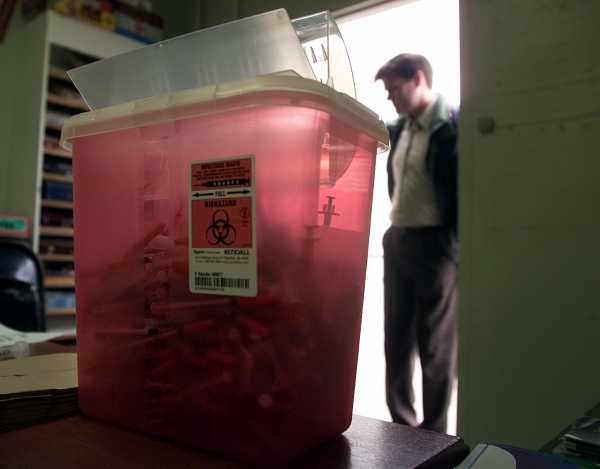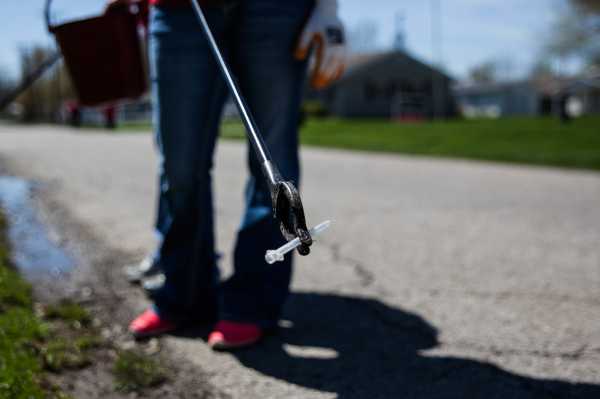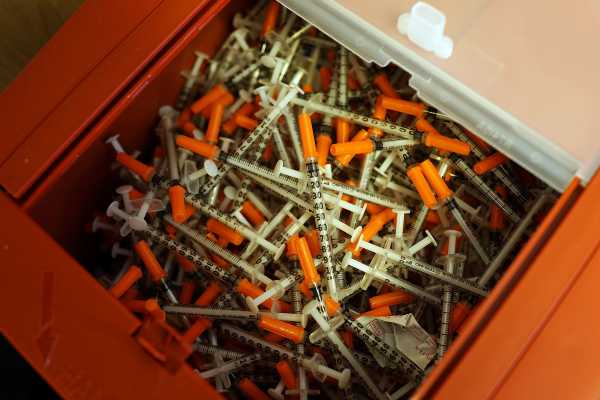
For Alex Smith, one of the key moments toward recovery from her heroin addiction was a smile — when, at a needle exchange program in Ventura County, California, a worker treated her with “humanity and dignity.” But now, Smith worries that fewer people will have that kind of experience after the only needle exchange in her new home of Orange County was shut down.
In 2012, Smith had a bad bacterial infection, MRSA, from reusing needles, with sores covering her face and body. She decided that she could no longer use the syringes she had been using and needed to get a clean supply. So she went to her local CVS.
“They took one look at me at CVS, and they turned me away. I felt so humiliated, disgusted. I didn’t know what to do,” Smith, now 31, told me. “I heard there was a mobile needle exchange in town. So I went to that. … I walked up, and there was a girl there. The first thing she did was smile at me and ask me how I was. I don’t know why that had such an impact on me. But it was the first time someone had treated me with dignity and humanity in a very, very long time.”
Smith went into treatment within weeks, and she said she hasn’t used drugs since then. She now works at a company that helps care for people with intellectual disabilities. She also recently graduated from college, and she got accepted to graduate school — a step, she hopes, toward helping run the company she now works for. “I wouldn’t have been able to do any of that unless I got sober,” Smith said.

Her experience with needle exchanges led her to volunteer with the program in Santa Ana in Orange County. She even sat on its board at one point, after it opened in 2016.
But in January of this year, the Santa Ana government shut down the exchange by denying it a permit for the local civic center.
The city’s justification focused on a common trope used against exchanges: needle litter — the idea that exchanges let people get a lot of syringes that are then improperly disposed in public places, exposing the public to the risk of getting inadvertently stuck by a needle.
Based on communications obtained by Vox, the Santa Ana program made changes and offered to take further steps in cooperation with the city to deal with needle litter. But city officials moved forward with closing down the exchange anyway.
The decades of research into needle exchanges is clear: The programs combat the spread of bloodborne diseases like hepatitis C and HIV, cut down on the number of needles thrown out in public spaces, and link more people to treatment — all without enabling more drug use.
Santa Ana’s case is emblematic of what’s happening in much of the country. In response to an opioid epidemic that’s been tied to tens of thousands of overdose deaths annually, more places have opened needle exchanges. But in some jurisdictions, the public and lawmakers have responded with opposition, getting the new programs shut down.
Santa Ana shut down Orange County’s only needle exchange
The volunteer-run, nonprofit Orange County Needle Exchange Program (OCNEP) opened its Santa Ana site in February 2016, after it got certification from the California Department of Public Health.
It was the first and only needle exchange in the county. It was open just two hours a week — on Saturday from 1 to 3 pm local time, when it typically saw 200 to 300 people. During that time, the program provided sterile needles to people and offered a place to safely discard syringes. It also linked people to other services, from birth control to preventive health care like HIV testing and vaccinations to addiction treatment.
“We were often shutting down before we could serve everybody,” Dallas Augustine, who’s on the board of directors for OCNEP, told me. “There was this unfathomable need that we hadn’t imagined at all when we began operating.”
The statistics show there really was a lot of need. Ben Brazil reported in the Los Angeles Times: “Santa Ana has the highest rate of HIV infection in the county, according to 2016 statistics from the Orange County Health Care Agency. There was a 201.2% increase in hepatitis C rates in Orange County from 2011 to 2015 since the last analysis from the California Department of Public Health.”
The program did not act as a one-to-one exchange — meaning a user didn’t need to trade in a needle to get one. Instead, it gave people the same amount of needles that they turned in plus 20. This less restrictive approach has become more common for exchanges as studies have found that providing a surplus of syringes leads to significantly lower chances of people reusing or sharing needles, which, in turn, reduces the risk of spreading infections.
City officials, however, argue that the needle exchange program led to more syringe litter in the area, providing pictures to media as proof.
“During the time that they were operational from 2016 to early 2018, we experienced an overwhelming increase of needle debris — not only in the Civic Center, but throughout the entire city,” Jorge Garcia, assistant to the Santa Ana city manager, told me. “Ever since the needle exchange program was removed here in the city, we have seen a dramatic decrease not only in the Civic Center but throughout the city of the proliferation of discarded needles.” (When asked, the city couldn’t provide any data to support this claim.)

Garcia argued that the city’s concern isn’t with the concept of needle exchanges but rather with how the Santa Ana program was run. He said that because the needle exchange was open only one day a week for two hours, it limited the time during which people could dispose of needles at the exchange — so people tossed out needles in other places, including in public spaces like the library and parks.
Garcia said that the program could have opened for longer to help deal with this issue. But he also clarified that the city would have objections to the program as long as it allowed people to obtain more needles than they traded in. That, he argued, was the root of the needle litter problems. “You can’t call it a needle exchange when it’s not a one-to-one ratio,” he said. “It was a needle distribution program.”
Before it was shut down, OCNEP said it had taken steps to limit needle litter — capping the number of syringes individuals could get at 200, requiring recipients to also get a large sharps container, and carrying out cleanup sweeps. By the end of the program, Augustine said, it actually disposed of more syringes than it gave out from week to week because of these measures.
According to emails and other communications obtained by Vox, OCNEP also offered more ideas to city officials to deal with needle litter, including opening for more hours and conducting more cleanup sweeps. The city was unreceptive or ignored the proposals.
In response to losing the city permit, the Santa Ana program is working on turning into a countywide mobile exchange, with an application into the California Department of Public Health. Since it will operate through a van, it only needs approval from the state, not local officials.
The new program aims to stay open for more hours — which, Augustine said, will hopefully help deal with the litter issue. The group will also walk around surrounding areas to pick up and dispose of improperly discarded syringes, and maintain a phone line and email address for people to report syringes.
Garcia said that Santa Ana has concerns about the mobile exchange, but the city has not taken an official stance yet. Other cities in the county have already voiced unease with a countywide exchange, arguing that the mobile program could be a “magnet for drug users.”
Needle exchanges work. Stigma holds them back.
The backlash in Orange County isn’t out of the ordinary. In response to the opioid crisis, more places across America have opened exchanges. That’s created more opportunities for backlash and resistance — with local jurisdictions in West Virginia and Indiana also shutting down needle exchanges, even as more open around the nation.
At the same time, the US lags far behind other developed countries when it comes to needle exchanges. Josh Katz reported at the New York Times: “According to the North American Syringe Exchange Network, 333 such programs operate across the country, up from 204 in 2013. In Australia, a country with less than a tenth as many people, there are more than 3,000.”
Ricky Bluthenthal, a professor of preventive medicine at the University of Southern California, has studied needle exchanges for decades. Bluthenthal, who supports the Orange County program, argued that outside the US, needle exchanges “are part and parcel of a gold-standard response to HIV and hepatitis C prevention.”
Exchanges are also backed by the American Medical Association, the Centers for Disease Control and Prevention, the World Health Organization, and President Donald Trump’s surgeon general.
One of the common criticisms is that these programs allegedly enable more drug use because they remove a hurdle (getting a sterile syringe) to using drugs.
But studies from independent researchers, the World Health Organization, and the Centers for Disease Control and Prevention have concluded that there’s no evidence that needle exchanges lead to more drug use. Instead, the studies found that exchanges reduce the spread of diseases that can infect people through injection drug use (such as HIV and hepatitis C) and help connect drug users to treatment.
In short, people will inject drugs with or without needle exchanges around. But if they don’t have access to new, sterile needles, they’ll just reuse a syringe that either they used before or that a peer used — both of which dramatically increase the risk of infection.
Santa Ana’s core concern, meanwhile, was that the needle exchange there led to more syringes discarded in public spaces. But studies suggest that needle exchanges, including those that aren’t one-to-one exchanges, actually reduce needle litter.
A 2012 study published in Drug and Alcohol Dependence compared a city with needle exchanges, San Francisco, to one without exchanges, Miami. Through visual inspections, they found 44 syringes per 1,000 census blocks in San Francisco, compared to 371 syringes per 1,000 census blocks in Miami. Based on a survey of injection drug users in both cities, the researchers also concluded that users in Miami had more than 34 times the adjusted odds to improperly dispose of syringes in public than users in San Francisco.

“These results suggest that [needle exchanges] are a significant means of collecting used syringes and do not increase the amount of publically discarded used syringes,” the study concluded.
In some ways, this should be intuitive: Needle exchanges provide a place to get syringes, but also a place to dispose of syringes.
Limited hours, like the Santa Ana exchange’s, do complicate the litter issue. San Francisco exchanges are open daily and for longer hours, which gives users in the city a more consistent place to drop off used syringes. Users at Santa Ana had no exchange to turn to for six days a week.
Still, Bluthenthal argued, the conclusion then should be that Santa Ana should have found a way to keep the exchange open for longer, not shut it down altogether. “In an ideal world, you would have a syringe exchange program open for 40 hours a week,” he said.
Bluthenthal made another point: To the extent that there is needle litter, the risk of someone getting inadvertently stuck by an improperly disposed syringe is, statistically, minimal. A 2011 study published in the American Journal of Public Health, for example, noted, “There have been no reports of HIV, [hepatitis B], or [hepatitis C] seroconversion among children who incurred accidental needlesticks.”
“It’s not even routinely quantified, it happens so infrequently,” Bluthenthal said.
From Bluthenthal’s perspective, stigma remains a key problem. After decades of the US treating addiction as a criminal justice problem instead of a public health concern, much of the public and many policymakers still view addiction as an issue that demands a punitive response, and see those with addiction as part of the problem instead of people who need help. (A common response to just about any opioid story I write, for instance, is that people dying from drug overdoses are just part of “Darwin’s theory in action.”)
So programs that help populations with addiction are quickly seen as disposable if they are linked, rightly or wrongly, to any problem whatsoever, regardless of the benefits they might produce.
Needle exchanges alone can’t solve the US’s opioid epidemic. Experts have said the crisis demands a suite of solutions, focused largely on providing more access to treatment but also more preventive strategies, such as reducing unnecessary opioid prescriptions, and more harm reduction approaches, including needle exchanges and safe injection sites.
Smith’s story, though, shows needle exchanges can play a role. When she volunteered at the Santa Ana program, she would tell people that she had been in their position before, and she was there to help if they needed it. In one case, a man at the exchange stayed for hours — after it closed — to talk to her and try to figure out how she overcame her own addiction. She doesn’t know if he ultimately got help, but her experience shows that this is the kind of interaction that will lead some people to get into care.
“It’s so much more than just needles,” Smith said. “Being treated with dignity and humanity, the power of that is insurmountable. It can shed so much light in the darkest of somebody’s times.”
Sourse: vox.com






